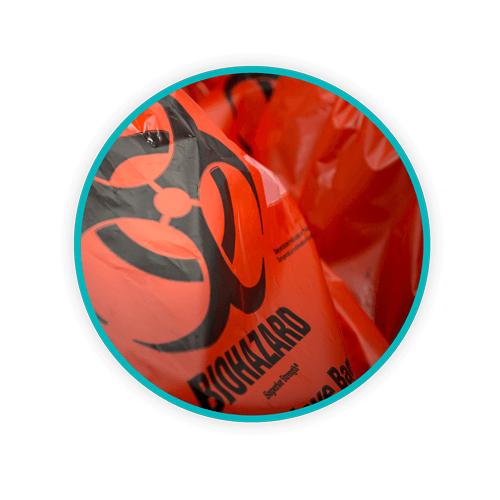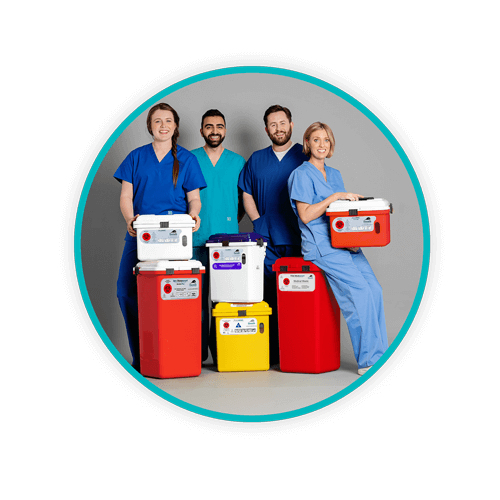What Is the Purpose of Double-Bagging Biohazardous Waste? And Why Should You Avoid It?

While it is worth knowing the purpose of double-bagging biohazardous waste, there are far more safe, sustainable and cost-effective alternatives to this practice. In this blog, we’ll explore why reusable, bagless bins are the ideal solution for your healthcare facility.
TOPICS WE WILL COVER:
1 / An Introduction to Biohazardous Waste Management
2 / Why the Downsides of Double Bagging Outweigh its Benefits
3 / Reusable, Bagless Waste Bins: A Practical Alternative
4 / Introducing the Daniels Health Range
An Introduction to Biohazardous Waste Management
Biohazardous waste includes any waste containing infectious materials or potentially infectious substances, such as blood that is saturated, dripping, or flakeable. It encompasses a wide range of materials and subcategories, from discarded sharps like needles and scalpel blades to cultures and stocks of infectious agents. The potential risks of biohazardous waste are significant, including the spread of infectious diseases and even environmental contamination.
Overview of Biohazardous Waste Types:
Biohazardous waste––also known as regulated medical waste (RMW), infectious waste or, colloquially, red bag waste––includes any solid or liquid waste contaminated with blood, human body fluids, or other materials that could potentially spread infections. This waste category encompasses a range of items and subcategories, such as pathological waste (human or animal body parts), anatomical waste (body parts), animal waste (carcasses, fluids), laboratory waste (specimen cultures, microorganisms), infectious waste (blood, excreta), sharps waste (needles, scalpels), and solid waste (contaminated bandages, dressings).
Proper segregation and disposal are crucial to prevent contamination and adhere to safety regulations. To read more about what constitutes biohazard waste, visit our knowledge center.
Why the Downsides of Double Bagging Outweigh Its Benefits
So, what is the purpose of double-bagging biohazardous waste? Double-bagging biohazardous waste is a method primarily used to prevent leakage and contamination, adding an extra layer of durability to the initial bag. However, traditional methods like double-bagging can pose significant environmental, safety, and financial challenges.
Environmental Impact:
The use of extra plastic bags contributes significantly to environmental degradation. The production and disposal of plastic bags generate greenhouse gasses and can lead to long-term pollution problems in landfills and natural environments.
Cost Implications:
Double-bagging can lead to increased costs for healthcare facilities due to the need for additional materials and the labor involved in handling the waste. These costs can add up, making waste management more expensive overall.
Risk of Contamination:
Ironically, the process of double-bagging can sometimes increase the risk of contamination. Handling and changing multiple bags can lead to accidental exposures and spills, posing health risks to waste handlers.
Reusable, Bagless Waste Containers: A Practical Alternative
Reusable, bagless waste containers offer a sustainable and safe alternative to double-bagging. These containers are designed to be durable, eliminating the need for additional containment measures and minimizing environmental impact.
Benefits of Reusable, Bagless Containers:
- Reduced Environmental Impact: By eliminating the need for disposable plastic bags, these bins significantly reduce plastic waste.
- Less Transmission Risk: The design of these bins often includes touchless features, reducing the risk of contamination during waste handling.
- Lower Long-Term Costs: Although the initial investment may be higher, the long-term savings from reduced material and labor costs make these containers a cost-effective solution.
Introducing the Daniels Health Range
Daniels Health offers innovative and sustainable alternatives that not only address the issues associated with double bagging biohazardous waste (and other non-hazardous waste streams) but also enhance overall efficiency and safety in healthcare facilities.
Regulated Medical Waste
The Daniels Medismart system is America’s leading clinically designed containment solution for regulated medical waste (RMW) disposal. As the first clinically-engineered bagless medical waste disposal container, Medismart is designed to eliminate hand contact and reduce infection risks in healthcare environments. This innovative container features a foot-pedal opening mechanism and a fully sealed design once full, ensuring a touchless, contamination-free experience for healthcare workers.
By prioritizing cleanliness and safety, the Medismart system dramatically reduces infection transfer risks associated with standard medical waste containers. Each full container is removed from the premises, emptied, and subjected to a six-stage robotic wash and sanitization process, ensuring a clean and safe environment for healthcare facilities.
Sharps Waste
For sharps waste, Daniels Health offers the Sharpsmart container, the world’s safest sharps container, which is clinically proven to reduce needlestick injuries by up to 87%.
The Sharpsmart container not only enhances safety for healthcare workers but also provides a sustainable alternative to traditional sharps disposal methods. With its innovative design and focus on minimizing injury risk, the Sharpsmart container ensures that sharps waste is managed efficiently and safely.
Non-Hazardous Pharmaceutical Waste
Daniels Health provides a secure and efficient solution for non-hazardous pharmaceutical waste through our Pharmasmart system.
These tamper-proof containers and secure servicing ensure peace of mind for healthcare facilities, protecting both staff and the environment from improper disposal of pharmaceutical products. By using our Pharmasmart system, healthcare facilities can confidently manage non-hazardous pharmaceutical waste, ensuring compliance with regulatory standards and maintaining a safe environment.
Trace Chemotherapy Waste Disposal
Daniels Health offers the first reusable containment system for trace chemotherapy waste in the United States, known as Chemosmart.
This system provides clinically engineered solutions that minimize cross-contamination and ensure safe disposal of trace chemotherapy waste. The Chemosmart containers are designed to be durable and efficient, reducing the environmental impact associated with disposable containment systems. By choosing Chemosmart, healthcare facilities can enhance their waste management practices while maintaining high safety standards.
Make the Switch Today
While double-bagging biohazard waste might initially seem like a practical solution, it has several drawbacks, including environmental harm, higher costs and potential contamination risks.
The reusable, bagless containers from Daniels Health offer a superior solution that address these issues effectively. With a focus on sustainability, safety, and cost-efficiency, Daniels stands out as a top choice for biohazardous waste management.
By shifting to reusable, bagless biohazardous waste bins, healthcare facilities can not only protect the environment but also enhance safety and reduce costs. Make the responsible choice with Daniels Health.
Let's Talk!
Your time is valuable, and we don’t want to play hard to get. You can either phone us directly on the details listed on our contact page, or feel free to fill out this short form and one of our team members will get back to you as quickly as possible.
